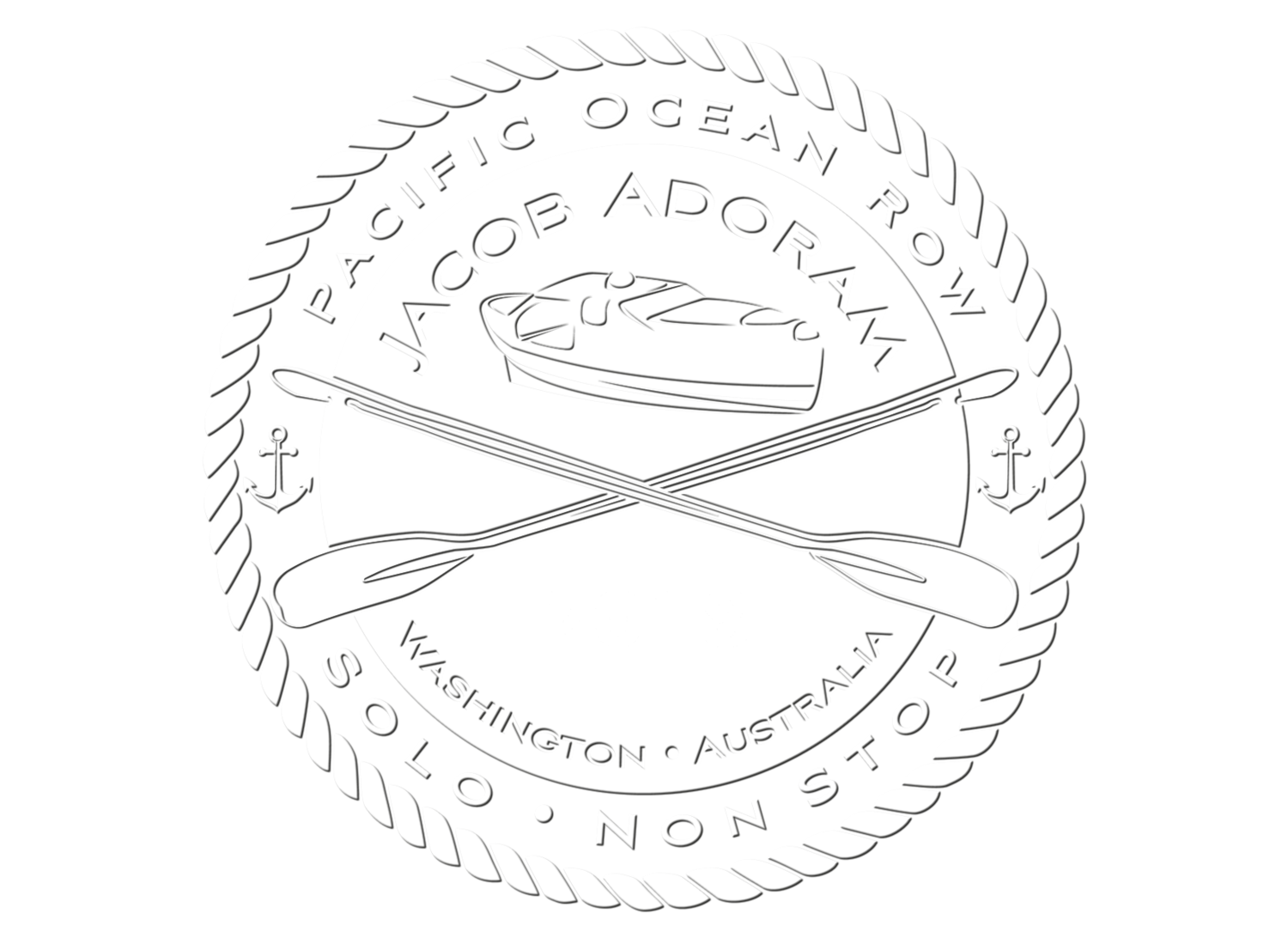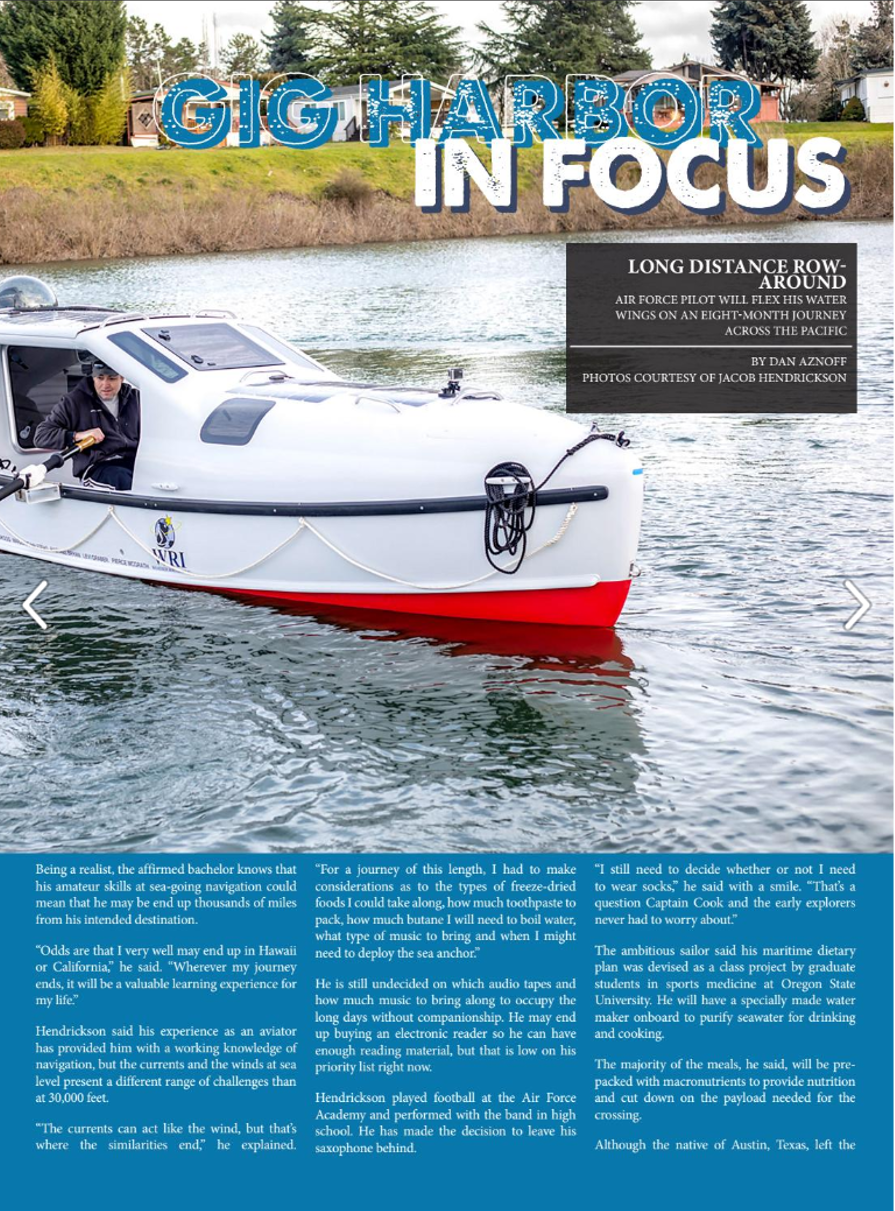Gig Harbor Living Local Magazine
Gig Harbor in Focus (Page 40) Text Only Version Below Images
Text Only Version Below
Air Force pilot will flex his water wings on an eight-month journey across the Pacific
By Dan Aznoff | Photo Courtesy of Jacob Hendrickson | Article provided by Gig Harbor Living
The challenge for a maritime resident of the Gig Harbor Marina will be how to explain to himself why in the world he chose to row his custom-made row boat across the 9,150 nautical miles from Neah Bay in Northwest Washington to Perth in Western Australia.
Air Force veteran Jacob Hendrickson knows a thing or two about adventure. He has first-hand experience with G-forces over the past 10 years flying combat missions over Afghanistan. He has pushed his reconnaissance jets to speeds that would make most sailors dizzy.
Then, during the long hot summer of 2014, he had an epiphany.
“Being an Air Force pilot had turned into just a job,” Hendrickson said with a straight face. “Flying combat missions can sometimes be difficult. But I was surprised when it actually became a bore.”
To cope with the tediousness routine of his dull life, the former Air Force Academy cadet challenged himself with the idea of propelling himself—alone—across the unpredictable ocean tides and treacherous currents between the West Coast of North America and the Land Down Under.
Weather permitting, he plans to begin his trek in early July but quickly added that he will delay his departure until he gets the eight to 10 days of good weather he’ll need to set a pace and his course for Australia.
His challenge, said Hendrickson, will test his ability to maintain his sanity that allows him “to understand the true definition of the term ‘grit.’”
The estimated eight-month crossing will force the jet jockey to “to experience patience and look inward at myself.”
The time alone with himself will not be a new experience.
“I currently live alone aboard a boat in the Gig Harbor Marina,” he said. “I live an isolated life. There will be no wife or kids anxiously waiting for me to walk ashore if, and when, I arrive in Perth.”
Being a realist, the affirmed bachelor knows that his amateur skills at sea-going navigation could mean that he may be end up thousands of miles from his intended destination.
“Odds are that I very well may end up in Hawaii or California,” he said. “Wherever my journey ends, it will be a valuable learning experience for my life.”
Hendrickson said his experience as an aviator has provided him with a working knowledge of navigation, but the currents and the winds at sea level present a different range of challenges than at 30,000 feet.
“The currents can act like the wind, but that’s where the similarities end,” he explained. “For a journey of this length, I had to make considerations as to the types of freeze-dried foods I could take along, how much toothpaste to pack, how much butane I will need to boil water, what type of music to bring and when I might need to deploy the sea anchor.”
He is still undecided on which audio tapes and how much music to bring along to occupy the long days without companionship. He may end up buying an electronic reader so he can have enough reading material, but that is low on his priority list right now.
Hendrickson played football at the Air Force Academy and performed with the band in high school. He has made the decision to leave his saxophone behind.
“I still need to decide whether or not I need to wear socks,” he said with a smile. “That’s a question Captain Cook and the early explorers never had to worry about.”
The ambitious sailor said his maritime dietary plan was devised as a class project by graduate students in sports medicine at Oregon State University. He will have a specially made water maker onboard to purify seawater for drinking and cooking.
The majority of the meals, he said, will be pre-packed with macronutrients to provide nutrition and cut down on the payload needed for the crossing.
Although the native of Austin, Texas, left the actual construction of his row boat to Schooner Boatworks in Portland, Hendrickson spent as much time as could spare at the factory to oversee the production. The concept for the ocean-going rowboat was the last boat designed by Eric Sponberg before his retirement. Hendrickson’s boat was featured in an article on the famed designer in a recent issue of Boat Builder magazine.
Sponberg was so proud of the craft he designed for the Air Force pilot, he included it on his personal website, EricWSponberg.com.
“My final boat design was an ocean-going rowboat for rowing solo, non-stop, across the Pacific Ocean. You can read about the history and development of my boat and mast designs on my new website.”
For his safety, Hendrickson will wear a four-point harness that will hopefully prevent him from being tossed overboard in rough seas. His 28-foot boat will weigh only 22 pounds before it will be stocked with provisions for the voyage.
The would-be captain was on hand to be part of the testing of the boat while under construction. The innovative design of the craft allowed it to right itself even if it was toppled over by high waves.
“I sat in the boat with the four-point harness when the boat was flipped during a test run,” he recalled. “My head was under water for only a few moments before the boat righted itself and I was vertical again.”
The safety precautions went beyond the design of the craft. Hendrickson said the row boat will be equipped with the latest in electronics to guard him against any unforeseen situations. He described the high-tech safety measures his own risk management plan.
The plan includes a satellite connection that will allow his volunteer support team to track the daily progress of the small craft as it crosses more than a dozen time zones. He will also carry a personal emergency beacon that can connect to a satellite system operated by the Federal Communications Commission.
So that he is never too far from modern conveniences, Hendrickson will also have unlimited access to texting friends and supporters around the world and access to a global rescue plane, if needed.
If the electronics fail, Hendrickson also plans to bring along a sextant, a compass and his watch, “Just in case.”
Finances were the largest obstacle to the journey for Hendrickson to overcome. His said his normal duties as a civilian contractor to the Armed Force commits him to two days on and two days off. His typical week over the past two years has been four days on and only one day off in order to build up the $800,000 in savings he estimates the adventure will ultimately cost.
The isolation, he said, will be a dramatic contrast to his normally hectic lifestyle.
“This was not an overnight decision,” Hendrickson concluded. “I jumped into this challenge with two feet into water that was over my head. No pun intended.”
The aviator predicted that his first order of business once he reaches dry land will be to eat a meal “that has not been pre-packaged or freeze-dried.”
Dan Aznoff is a freelance writer based in Mukilteo dedicated to capturing the cherished memories of our lifetime so that they may be passed to future generations. He was a finalist for the Pulitzer Prize for his coverage of the toxic waste crisis. Aznoff can be contacted directly at da@dajournalist.com.




